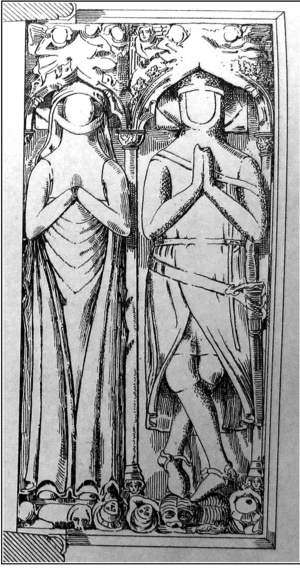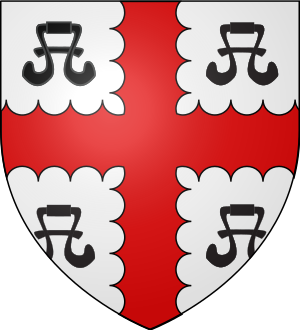John de Bourchier facts for kids
John de Bourchier (who also went by Boussier) was an important English judge who lived around the 1300s. He was a judge in a special court called the Common Pleas. John de Bourchier is the earliest known ancestor of the famous Bourchier family. This family became very powerful over time, holding many important titles like Barons, Earls, and Viscounts.
Contents
Where Did the Bourchier Family Come From?
People aren't sure if the Bourchier family originally came from France or if they were an old English family. Scribes (people who wrote documents) used to write their name in Latin as de Burgo Caro, which meant "from the costly town." This was a French way of saying "le Bourg Cher."
John's Early Career
John de Bourchier first appears in records in 1306. He was chosen by a powerful lord, Robert de Vere, to represent him in Parliament. This Parliament was called to raise money when the Prince of Wales (who would later become King Edward II) was made a knight.
In 1312, John paid a fine to delay becoming a knight himself. Being a knight was a great honor, but it was also very expensive!
Between 1314 and 1315, John was listed as a Justice of Assize for several counties, including Kent and Sussex. These judges traveled around to hear cases. He also worked on various special committees in the years that followed.
On May 15, 1321, John was called to Parliament as a judge for the first time. Soon after, on May 31, 1321, he was officially appointed as a Justice of the Common Pleas. This was a big step in his career.
John's Work as a Judge
As a judge, John de Bourchier handled many interesting cases.
- In 1322, he oversaw the trial of people who had illegally entered the lands of a powerful lord, Hugh le Despenser.
- He also investigated claims of corruption against officials in Kent, Surrey, and Sussex.
- He heard cases where sheriffs and other officers were accused of demanding too much money from people in Essex and other areas.
One unusual case in 1322 involved people accused of faking miracles near a gallows (where criminals were hanged). John was part of the special group that investigated this.
In February 1326, John led a group of judges to hear a case about poaching (illegal hunting or fishing). The Bishop of London and St Paul's Cathedral accused people of catching a very large fish, called a "cete" (which means tuna), from their land. The church claimed they had the right to all large fish found on their estates, except for the tongue, which belonged to the king.
Later in 1326, he continued to try cases of officials taking too much money in different parts of England. John was called to Parliament for the last time in December 1326.
After King Edward III became king in 1327, John was reappointed as a Justice of the Common Pleas. His official document for this was dated March 24, 1327. The last time a fine was officially recorded before him was on Ascension Day in 1329.
Family Life and Home
John de Bourchier married Helen of Colchester. She was the daughter and heir of Walter of Colchester. Through his marriage to Helen, John inherited a large estate called Stanstead in Halstead, Essex. He had also bought some land nearby in 1312.
John made his home at Stanstead Hall. By the 1800s, only one part of the old hall was left, being used as a farm house. Today, you can still see the remains of the old moated site (a ditch filled with water around a building) and an ancient chapel. A larger, newer Stanstead Hall from the 1500s is also nearby.
John and Helen had at least one famous child:
- Robert Bourchier, 1st Baron Bourchier (died 1349), who became a very important official called the Lord Chancellor.
Death and Burial
John de Bourchier passed away shortly after Ascension Day in 1329. We know this because his son, Robert Bourchier, was given control of his father's estates by the king the following year.
Some records suggest he was buried in Stanstead Church. However, it is more commonly believed that he was buried in St Andrew's Church in Halstead. In this church, there are two stone statues lying down, which are thought to represent John de Bourchier and his wife.
Sources
- Rigg, James McMullen, biography of Sir John de Bourchier published in Dictionary of National Biography, 1885–1900, Vol.6 (Text in public domain)



